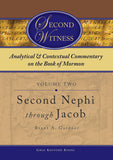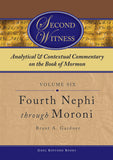News
On the third day of Kofford: 30% off personal essay titles! December 03 2016

All personal essay titles are 30% off on December 3rd. These special prices are only available for one day, so don't wait!
Orders over $50 qualify for free shipping. Also, local Utah customers can opt to pick up their order directly from our office in Sandy (select this option under the shipping menu).
For more information about the Twelve Days of Kofford holiday sales, click here.
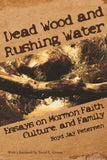 |
Dead Wood and Rushing Water: Essays on Mormon Faith, Culture, and Family Retail: $22.95 |
 |
Mr. Mustard Plaster and Other Mormon Essays Retail: $20.95 |
 |
Writing Ourselves: Essays on Creativity, Craft, and Mormonism Retail: $18.95 |
On the second day of Kofford: 30% off Adam Miller titles! December 02 2016

Adam Miller's Essays in Mormon Theology titles will be 30% off on December 2nd. These special prices are only available for one day, so don't wait!
To get the 30% discount, simply enter the code MILLERCHRISTMAS (all caps) in the discount code box at check-out.
Orders over $50 qualify for free shipping. Also, local Utah customers can opt to pick up their order directly from our office in Sandy (select this option under the shipping menu).
For more information about the Twelve Days of Kofford holiday sales, click here.
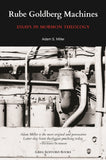 |
Rube Goldberg Machines: Essays in Mormon Theology Retail: $18.95 |
 |
Future Mormon: Essays in Mormon Theology Retail: $18.95 |
On the first day of Kofford: all Brant Gardner titles 30% off retail price! December 01 2016

Greg Kofford Books is pleased to offer 30% off of the following titles on December 1st. These special prices are only available for one day, so don't wait!
To get the 30% discount, simply enter the code BOOKOFMORMON (all caps) in the discount code box at check-out.
Orders over $50 qualify for free shipping. Also, local Utah customers can opt to pick up their order directly from our office in Sandy (select this option under the shipping menu).
For more information about the Twelve Days of Kofford holiday sales, click here.
Twelve Days of Kofford Christmas Sale 2016 November 30 2016
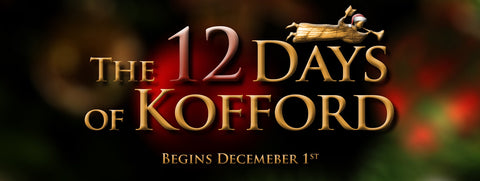
MERRY CHRISTMAS FROM GREG KOFFORD BOOKS
Greg Kofford Books is pleased to announce our annual holiday sale on select popular titles beginning December 1st – December 12th.
Here's how it works: at the stroke of midnight each day, a new blog post will go live on our website listing that day's special offerings along with a discount code that you can enter at check-out to get the holiday price. It's that simple. We will also be posting the daily offering and discount code on our Facebook page at 7am.
*Orders over $50 qualify for free shipping (continental U.S. customers only). Local Utah customers can stop by our office in Sandy to pick up their orders as well. Holiday inventory on some titles may be limited, so be sure to take advantage of the daily sale early.*
To help you plan in advance, here are our scheduled sales:
Day 1 — Brant Gardner titles
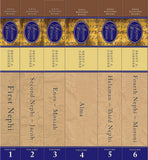 |
Second Witness: Analytical & Contextual Commentary on the Book of Mormon series
|
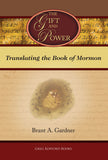 |
The Gift and Power: Translating the Book of Mormon |
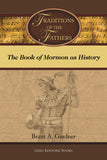 |
Traditions of the Fathers: The Book of Mormon as History Best Religious Non-fiction Award, Association for Mormon Letters |
Day 2 — Adam Miller titles (essays in Mormon theology)
 |
Rube Goldberg Machines: Essays in Mormon Theology Retail $18.95 |
 |
Future Mormon: Essays in Mormon Theology Retail: $18.95 |
Day 3 — Personal Essays
 |
Dead Wood and Rushing Water: Essays on Mormon Faith, Culture, and Family Retail: $22.95 |
 |
Mr. Mustard Plaster and Other Mormon Essays by Mary Lithgoe Bradford Retail: $20.95 Sale price: $14.67 |
 |
Writing Ourselves: Essays on Creativity, Craft, and Mormonism Retail: $18.95 |
Day 4 — Blake T. Ostler titles
 |
Exploring Mormon Thought series by Blake T. Ostler 30% off each title |
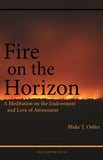 |
Fire on the Horizon: A Meditation on the Endowment and Love of Atonement Retail: $17.95 |
Day 5 — Contemporary Studies in Scripture
 |
Authoring the Old Testament: Genesis — Deuteronomy Retail: $26.95 |
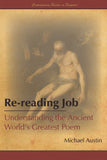 |
Re-reading Job: Understanding the Ancient World's Greatest Poem Retail: $20.95 |
 |
Search, Ponder, and Pray: A Guide to the Gospels Retail: $27.95 |
 |
Beholding the Tree of Life: A Rabbinic Approach to the Book of Mormon Retail: $21.95 |
 |
The Vision of All: Twenty-five Lectures on Isaiah in Nephi's Record Retail: $25.95 |
Day 6 — International Mormonism
 |
The Trek East: Mormonism Meets Japan, 1901–1968 Retail: $39.95 |
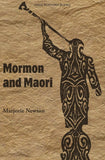 |
Mormon and Maori Retail: $24.95 Best International Book Award, Mormon History Association |
 |
Tiki and Temple: The Mormon Mission in New Zealand, 1854–1958 Retail: $29.95 Best International Book Award, Mormon History Association |
 |
For the Cause of Righteousness: A Global History of Blacks and Mormonism, 1830–2013 Retail: $32.95 Best Book Award, Mormon History Association |
 |
The History of the Mormons in Argentina Retail: $24.95 |
 |
From Above and Below: The Mormon Embrace of Revolution, 1840 – 1940 Retail: $34.95 Best International Book Award, Mormon History Association |
Day 7 — Polygamy titles
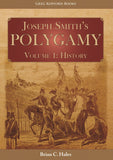 |
Joseph Smith's Polygamy: History and Theology Now in paperback! 30% off each title |
 |
Joseph Smith's Polygamy: Toward a Better Understanding Retail: $19.95 |
 |
Modern Polygamy and Mormon Fundamentalism: The Generations after the Manifesto Retail: $31.95 Best Book Award, John Whitmer Historical Association |
 |
Mormon Polygamous Families: Life in the Principle Retail: $24.95 |
 |
Prisoner for Polygamy: The Memoirs and Letters of Rudger Clawson at the Utah Territorial Penitentiary, 1884–87 Retail: $29.95 |
Day 8 — Contemporary Issues
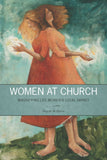 |
Women at Church: Magnifying LDS Women's Local Impact Retail: $21.95 |
 |
Common Ground—Different Opinions: Latter-day Saints and Contemporary Issues Retail: $31.95 |
 |
The Liberal Soul: Applying the Gospel of Jesus Christ in Politics Retail: $22.95 |
 |
Voices for Equality: Ordain Women and Resurgent Mormon Feminism Retail: $32.95 |
Day 9 — Biography
 |
Hugh Nibley: A Consecrated Life Retail: $32.95 Best Biography Award, Mormon History Association |
 |
“Swell Suffering”: A Biography of Maurine Whipple Retail: $31.95 Best Biography Award, Mormon History Association |
 |
William B. Smith: In the Shadow of a Prophet Retail: $39.95 Best Biography Award, John Whitmer Historical Association |
 |
The Man Behind the Discourse: A Biography of King Follett Retail: $29.95 |
Day 10 — War and Peace
 |
War & Peace in Our Time: Mormon Perspectives Retail: $29.95 |
 |
Even unto Bloodshed: An LDS Perspective on War Retail: $29.95 |
 |
The End of the World, Plan B: A Guide for the Future Retail: $13.95 |
 |
Saints of Valor: Mormon Medal of Honor Recipients, Updated 2nd Edition Retail: $31.95 |
Day 11 — Mormon Image in Literature
 |
The Mormoness; Or, The Trials Of Mary Maverick: A Narrative Of Real Events Retail: $12.95 |
 |
Boadicea; the Mormon Wife: Life Scenes in Utah Retail: $15.95 |
Day 12 — Ebook Flash Sale — $1.99 for select titles
To be announced. Stay tuned!
Black Friday Sale: 40% Off Church History and Doctrine Titles! November 21 2016

GET READY FOR NEXT YEAR'S GOSPEL DOCTRINE CLASS WITH ESSENTIAL READING IN CHURCH HISTORY AND DOCTRINE
Helpful resources for understanding the historical setting of Joseph Smith's Ohio revelations—which comprise the majority of the Doctrine and Covenants—the Law of Consecration, and the development of Mormon theology:

|
Hearken, O Ye People: The Historical Setting of Joseph Smith's Ohio Revelations by Mark Lyman Staker Winner of the Best Book Award from the Mormon History Association and the John Whitmer Historical Association “Sets a new standard of in-depth research in Latter-day Saint history.” — Richard L. Bushman, author of Joseph Smith: Rough Stone Rolling $34.95 hardcover |
 |
For Zion: A Mormon Theology of Hope “The most ambitious scholarly engagement with the law of consecration since Hugh Nibley’s Approaching Zion.” — By Common Consent $19.95 paperback |
 |
“This is My Doctrine”: The Development of Mormon Theology “Because he does not attempt to square circles by making Mormon doctrine consistent over time, Harrell’s encyclopedic survey of Mormon doctrine is more stimulating and more insightful than most other books on Mormon doctrine.” — James McLachlan, Professor of Philosophy and Religion at Western Carolina University $34.95 hardcover |
Understanding the Missouri conflict and the building of Nauvoo:
 |
Fire and Sword: A History of the Latter-day Saints in Norther Missouri, 1836–39 “Gentry used more thoroughly than any scholar before him the official documents published by the State of Missouri and the U.S. Senate in the aftermath of the Mormons’ departure from the state, which contained the correspondence between Boggs and his militia commanders.” — The Juvenile Instructor $36.95 hardcover |
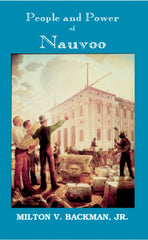 |
Drawing on numerous journals and other primary sources, Professor Backman sketches for us the founding, growth, and development of Nauvoo. $12.95 paperback |
 |
A House for the Most High: The Story of the Original Nauvoo Temple “A wealth of information about the details of building the temple and also a glimpse into the working of the Church during this same period.” — Association for Mormon Letters $29.95 paperback |
Understanding the life of the prophet Joseph Smith, including his controversial practice of polygamy:
 |
Knowing Brother Joseph Again: Perceptions and Perspectives “A thoughtful and thought-provoking introductory text for someone wanting an overview of Joseph Smith.” — Improvement Era $19.95 paperback |
 |
Joseph Smith's Polygamy, Volume 1: History “There has never been a more thorough examination of the polygamy idea.” — Richard L. Bushman, author of Joseph Smith: Rough Stone Rolling $34.95 paperback |
 |
Joseph Smith's Polygamy, Volume 2: History “[A] landmark in the historiography of Mormon polygamy.” — Todd M. Compton, author of In Sacred Loneliness: The Plural Wives of Joseph Smith $34.95 paperback |
 |
Joseph Smith's Polygamy, Volume 3: Theology “[T]he standard against which all other treatments of this important subject will be measured.” — Danel W. Bachman, author of “A Study of the Mormon Practice of Plural Marriage before the Death of Joseph Smith” $25.95 paperback |
 |
Joseph Smith's Polygamy: Toward a Better Understanding “Despite the book's brevity, it is detailed enough to address, or touch on, the full range of controversies associated with this topic.” — BYU Studies Quarterly $19.95 paperback |
Become well-informed about the pioneer trek to Utah and emergence of modern Mormonism, including the development and reversal of race-based priesthood restriction as well as international growth of the Church:
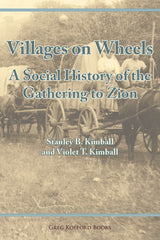 |
Villages on Wheels: A Social History of the Gathering to Zion “A riveting compilation for any reader looking to discover this monumental and defining experience in Mormon history through the accounts of the common people who lived it.” — BYU Studies Quarterly $24.95 paperback |
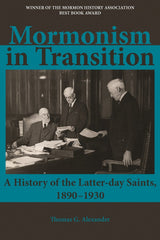 |
Mormonism in Transition: A History of the Latter-day Saints, 1890–1930 Winner of the Best Book Award from the Mormon History Association “Will be required reading for all historians of Mormonism for some time to come.” – Journal of American History $31.95 paperback |
 |
For the Cause of Righteousness: A Global History of Blacks and Mormonism, 1830–2013 Winner of the Best Book Award from the Mormon History Association “Brings together a wealth of sources to create this ambitious and quick-moving but detailed overview of the intersection of Latter-day Saint and black history.” — The Journal of Mormon History $32.95 paperback |
Preview The Garden of Enid: Adventures of a Weird Mormon Girl, Part One November 01 2016

The Garden of Enid:
Adventures of a Weird Mormon Girl, Part One
Q&A with Shinji Takagi for The Trek East: Mormonism Meets Japan, 1901-1968 October 06 2016
Hardcover $69.95 (ISBN 978-1-58958-561-4)
Order Your Copy Today
Q. Can you give us a brief background on yourself, both academically and professionally, and what led to your interest in researching this topic?
A. I am an economist by profession. I have been an academic for about 20 years of my professional career and an international civil servant for about 15 years. As an academic, I have also held appointments with Japanese government agencies and consulted for several international organizations. My specialty is international monetary economics. My professional work has involved a number of developed, emerging, and developing economies across the world. At present, I am engaged in work on low-income country cases.
My book discusses the encounter of Mormonism with Japan. Perhaps I should explain how I first encountered America some 45 years ago as a way of introducing my background. When I was growing up in Japan as a child, I had no idea that I would be spending nearly half of my adult life in the United States. Rather accidentally, I received a scholarship to study at an American college toward the end of my senior year in high school. The sponsor was an educational fund called the Grew Foundation, established in 1950 with support from Japan’s leading political and business leaders. It bears the name of a former American ambassador to Japan, Joseph C. Grew, who contributed seed money to the fund. The foundation’s aim was to provide opportunities for American-style liberal arts education to Japanese students who might then become instrumental in rebuilding Japanese–American relations in the postwar era. I would like to think I have made some progress toward this aim by writing this book.
I explain in the preface of the book how I became interested in Japanese Mormon history almost by chance—I was asked to translate an English text on the subject. It was the scholar in me (“curiosity and preoccupation with accuracy”) that kept my interest alive thereafter. It has taken me nearly 25 years of part-time, intermittent work to complete the book! Looking back, I feel I was compelled to write this book.
Q. For readers who are not familiar with the history of LDS missionary work in Japan, can you give us a short summary of activity?
A. Japan was one of the first non-Christian nations to receive Mormon missionaries. LDS missionary work began in 1901 and continued until 1924. Missionaries returned to Japan in 1948, three years after the end of World War II. My book covers not only the periods of Mormon missionary activity in Japan, from 1901 to 1924 and from 1948 to 1968, but also the period when the Church was absent. LDS missionary work is still ongoing, but the book’s coverage ends in 1968 when the mission in Japan was divided into two entities.
Q. What sets The Trek East apart from other books and articles written on the topic of LDS missionary work in Japan?
A. Two things set this book apart from others. First, I do not rely solely on English-language sources. Second, I try to interpret the historical contexts of major events and decisions. These two things, of course, are not independent. Interpretation of historical contexts would be impossible if you were relying on English sources alone. In making these remarks, I am not taking anything away from previous authors. It is their writings that have allowed me to go further.
Q. Early LDS missionary work in Japan is often considered a failure. What do you think contributes to this perspective?
A. A mass conversion of the type experienced, for example, in the British Isles never happened in Japan. That this did not happen may have been a disappointment to some Church leaders, who had hoped that the blood of Israel should make the Japanese people receptive to the Mormon message. Whatever the reason, the Church subsequently did not devote the resources necessary to make a viable presence. The average number of missionaries serving at any one time was about 13 for a country half the population of the United States. I give the subtitle “failure or forfeit?” to the chapter where I discuss these issues. Did the work inherently fail or did it only appear to fail because the Church did not make enough effort? I don’t pretend to give a definitive answer.
Q. Some observers have blamed the disintegration of U.S. and Japan relations for the perceived failure in early LDS missionary work in Japan. What are your thoughts on this?
A. Political events, including international relations, clearly impacted the Mormon experience in the period preceding World War II. I devote a considerable part of the book to discussing how Japanese–American relations may have influenced the Church’s decision to close the mission in 1924. An important point I make is that those who have related the mission’s closing to international politics made their remarks from the vantage point of the postwar era, when the war and the events in Japan that had led up to it were a fait accompli. The war became the convenient explanation for an uncomfortable event in the history of the Church.
Q. What does the history of LDS missionary work in Japan teach us about international missionary work in general?
A. Writing this book has not qualified me to answer this question, except to say that the productivity of LDS missionary work appears to depend on the evolving religious and intellectual climate of a society. The window of opportunity, when there is a radical societal change, is typically short. To take advantage, the Church needs to devote a critical mass of resources quickly. The LDS Church is much better placed to do so today, given the resources now available, than it was in Japan, for example, during the immediate postwar period.
Order Your Copy Today
Preview The Vision of All: Twenty-five Lectures on Isaiah in Nephi’s Record September 13 2016
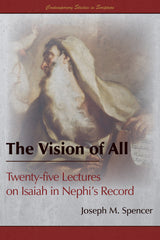
The Vision of All:
Twenty-five Lectures on Isaiah in Nephi’s Record
Preview The Trek East: Mormonism Meets Japan, 1901–1968 August 23 2016
The Trek East:
Mormonism Meets Japan, 1901–1968
Q&A with Julie M. Smith for As Iron Sharpens Iron July 26 2016

Pre-order Your Copy Today
Q: Give us a little background into how this project started.
A: I read a review copy of Matthew Richard Schlimm's This Strange and Sacred Scripture: Wrestling with the Old Testament and Its Oddities. Its aim is to help the modern reader figure out what to do when a work they regard as sacred seems to promote genocide, slavery, etc. There is a brief section in the book—just a page or two—where he presents a fictitious dialogue between Ruth and Ezra. Ezra is the one who commands the Israelites to divorce their foreign wives. Ruth, of course, is a foreign wife. Now, in real life, they never had this conversation—they didn't even live at the same time. But Schlimm has created this conversation that shows them exploring their positions on what we would call interfaith marriage. It is civil, but neither concedes. They explore their disagreement. This dialogue stuck in my mind. A few weeks later, I was still thinking about it. I wished that I could read an entire book of dialogues like that. And since I know some pretty clever people, I decided to ask them to write a book like that for me.
Q: Why is it important for readers of scriptures to understand that there are various, sometimes even contesting, views within the scriptures?
A: Usually, one of two things happens: we either don't read closely enough to notice that there are differences, or, as soon as we notice the differences, we work as hard and as quickly as we can to come up with some theory that makes the difference disappear. But what if the contesting views are supposed to be there? What if they are a feature and not a bug? This book is an exercise in exploring those differences. If they are there, they are a feature of the scriptures, and we might just be able to learn something from them.
Q: Why did you choose to portray these different views within scriptures as fictionalized dialogues among scriptural figures? Does this approach tie into a more anciently-practiced approach to scriptural hermeneutics?
A: In some ways it is similar to the Jewish practice of midrash because it is creative and because it goes beyond the text itself. But whereas midrash often tries to fill “gaps” or solve problems, it was important to me that we specifically not do that, but rather try to stay true to the text itself. As far as using fictionalized dialogues, it seemed to be a reader-friendly manner of presenting the diverging opinions. It also models civil dialogue—something I think this current moment is lacking and might benefit from seeing modeled.
Q: What are some of the larger themes within scripture that are particularly relevant to a modern audience?
A: Can I say “all of them”? I'm not sure there is much that they wrestled with that we don't, at least in some iteration. For example, my dialogue concerns Mark and Luke discussing (or, as Ben Peters described it, “mansplaining”) women's proper roles. Luke's viewpoint is that we honor women by honoring what women have traditionally done; Mark's is that we honor women by removing restrictions from their behavior. But is Mark's view requiring women to act like men in order to be worthy of honor? Is Luke's view too limiting of what women can do? It's 2,000 years later and we are still having precisely the same conversation about women's roles. This is true for all of the dialogues.
Q: Can you provide an example or two of topics that casual readers may assume unity among Biblical writers that, upon closer scrutiny, may actually show tension?
A: Nicholas Frederick has a great piece contrasting the different views about the nature and divinity of Jesus within the New Testament. Heather Hardy's piece highlighting the different ways that Joseph (in the Old Testament) and Nephi think about rivalry and reconciliation with their siblings is just fantastic. Ronan James Head writes about contrasting views of Satan.
Q: How does understanding the different views and ideas presented in scripture help us to have a deeper, more rewarding experience in reading them?
A:Well, I find the places of tension to be the most productive locations for really pondering because they raise such important questions about how to resolve those tensions. I'm a big proponent of the idea that when you are pondering and wrestling, you are creating space for the Spirit to speak as you let the questions tumble around.
Pre-order your copy today.
New from The Mormon Image in Literature Series: Boadicea — now available! July 14 2016

NOW AVAILABLE from The Mormon Image in Literature series:
Boadicia; The Mormon Wife: Life-Scenes in Utah
by Alfreda Eva Bell
Edited and annottated by Michael Austin and Ardis E. Parshall
About the series:
The Mormon Image in Literature reprints important literary works by and about Mormons—from the sensational anti-polygamy books and dime novels of the Civil War era to the first attempts of Mormon writers to craft a regional literature in their Great Basin kingdom. Each volume contains a critical introduction, helpful annotations, and multiple appendices that enlighten and enliven the text. These volumes have been designed for both Mormon and non-Mormon readers who want to understand the cultural importance of Mormonism during the first Latter-day Saint century.
From series co-editer, Michael Austin:
“Much of this work will be just as interesting to historians as to scholars of literature. In fact, some of the work with the least literary merit has the greatest historical interest. Boadicea: The Mormon Wife, which will be the second volume in the series, will probably never be accused of literary greatness. But it has been written about by some of the top figures in Mormon History: Leonard Arrington, Terryl Givens, Sarah Barringer Gordon, Paul W. Reeve.
The literature of the 19th century had very little subtlety when it came to portraying Mormons. The overwhelming majority of volumes featured Mormon elders living in harems and forming Danite bands to hunt down and kill dissenters. And this was not just in the tawdry literature. Both Robert Louis Stevenson and Arthur Conan Doyle wrote novels that portrayed Mormons in these ways.”
Read the complete Q&A here.

Boadicea; the Mormon Wife: Life-Scenes in Utah
Part of The Mormon Image in Literature series
by Alfreda Eva Bell
Edited by Michael Austin and Ardis E. Parshall
151 Pages
ISBN 978-1-58958-566-9
$15.95 (paperback)
Also available in ebook
First published in 1855, Boadicea; the Mormon Wife belongs to a sub-genre of crime fiction that flourished in the Eastern United States during the 1850s. Boadicea has become increasingly important to scholars of Mormonism because it gives us a glimpse of the Mormon image in literature immediately after the Church’s public acknowledgement of plural marriage. Over the next half century, this image would be sharpened and refined by writers with different rhetorical goals: to end polygamy, to attack Mormon theology, or just to tell a highly entertaining adventure story. In Boadicea, though, we see these tropes in their infancy, through a prolific author working at break-neck speed to imagine the lives of a strange people for readers willing to pay the “extremely low price of 15 cents” for the privilege of being amazed by stories of polygyny and polyandry, along with generous helpings of adultery, seduction, kidnapping, and no fewer than fourteen untimely but spectacular deaths: people are shot, stabbed, bludgeoned, poisoned, hanged, strangled, and drowned. No other novel of the nineteenth century comes anywhere near Boadicea in portraying Mormon society as violent, chaotic, and dysfunctional.
Preview Boadicea
About the series editors:
Michael Austin is the author or editor of seven books and more than 50 articles, book chapters, and reviews, including Re-reading Job: Understanding the Ancient World’s Greatest Poem. He is currently the Provost and Vice President of Academic Affairs at Newman University in Wichita, Kansas.
Ardis E. Parshall is a historian, freelance researcher specializing in Mormon history, and author. She co-edited with Paul Reeve Mormonism: A Historical Encyclopedia and is currently writing She Shall Be an Ensign, a history of the LDS Church told through the lives of Mormon women. She blogs at Keepapitchinin.
Preview Saints of Valor: Mormon Medal of Honor Recipients June 30 2016

Saints of Valor:
Mormon Medal of Honor Recipients,
Updated 2nd Edition
Preview As Iron Sharpens Iron: Listening to the Various Voices of Scripture June 16 2016
As Iron Sharpens Iron:
Listening to the Various Voices of Scripture
Preview Boadicea; the Mormon Wife: Life Scenes in Utah June 16 2016
Boadicea; the Mormon Wife: Life Scenes in Utah
Q&A with Jack Harrell, author of Writing Ourselves: Essays on Creativity, Craft, and Mormonism May 30 2016
Pre-order your copy today.
Can you name a few writers who have had the greatest influence on you? What draws you to their work?
My favorite writer is Flannery O’Connor. Her fiction is fantastic, and her essays and letters on writing are full of insight and humor. Back in 1994, at Illinois State University, I did my master’s thesis on her novel Wise Blood. Her work speaks to a lot of Mormons because she’s unapologetic about her Catholic faith. Though her writings are obviously religious, she doesn’t slip into oversimplification or didacticism. And plenty of readers who aren’t religious find satisfaction and meaning in her work. Her writing works on a number of levels. I also appreciate writers like Wallace Stegner, Raymond Carver, and Willa Cather.
Among Mormon writers, Levi Peterson is very important, I think—a must-read. And I think any Mormon interested in good writing should read Virginia Sorensen’s 1963 story collection Where Nothing is Long Ago: Memories of a Mormon Childhood.
I’m drawn to small-town characters and settings in the contemporary West and the Midwest, probably because that’s the world I know best. That’s what I’m interested in writing about, too—telling the stories of ordinary folks in these small towns.
Lately I’ve been reading contemporary philosophers amenable to a religious viewpoint. John Polkinghorne is one I like. He’s an Anglican priest and theologian with two PhDs in physics. I’ve also learned a great deal from the writings of Roger Scruton, especially from his books The Face of God, The Soul of the World, and Beauty.
The last book I read was a Greg Kofford publication: Future Mormon, by Adam S. Miller. It’s great to see a tradition of thoughtful scholarship continue among Latter-day Saints like Miller.
Some label the religious seeker as being on a quest for an epiphany. Can you discuss how epiphany in a spiritual sense is related to epiphany in a creative sense?
Long before James Joyce made it a literary term, the word “epiphany” was a religious term referring to some profound insight from the divine. I believe most religious people, no matter what their faith, seek communion with the divine, or just a connection with something beyond themselves. I think very few people would see the human race as the greatest force or power in the universe; and even if they do, they’d still admit those times when we reach for something greater within us. Isn’t this the quest of most art? To reach for something higher?
Of course, there are a few who would say, “There’s nothing great within us, nothing great beyond us. Therefore, art should express that. Art should be against epiphanies, against transcendence. Art should be being emphatically ugly because ugliness and entropy is all we have.” But that’s a pretty rare position to take, and pretty cynical too.
It seems to me that the very act of creation is rooted in a desire to make something outside of ourselves that expresses what we see or feel within. Maybe every artist is just trying to meet himself or herself, trying to understand and recognize what’s there.
In the sixth chapter, you discuss teaching students to write. You mention the Mormon “struggle to tell the truth.” Why do Mormons struggle with superficiality in their writing?
It’s not just a Mormon struggle. It’s human nature to fall back on easy answers and struggle to tell the truth. We’re all guilty of horizontal thinking: worrying about what the person next door thinks rather than doing what we know to be true. Honesty with ourselves is a normal human struggle too. We all create fictions to justify the way we live and the way we see the world. Some of the lies we tell emerge from our good intentions. We just don’t want to hurt someone’s feelings.
It’s the same with Mormons. We don’t want to hurt people, we’re worried about what our neighbors think, and we want to keep things pleasant. But life isn’t always pleasant. Conflict is at the heart of meaningful stories. If we avoid conflict, we hamstring good stories. The scriptures are full of conflicts. Church history isn’t the simple story that some once thought it to be. There are all kinds of complex layers at work in the scriptures and in Church history and in all our lives.
I think, more and more, we’re going to see that easy answers don’t cut it. We need to face complexities, not avoid them. As the teachings of the Church grow more at odds with secular society, we’re going to have to embrace the complexities of our own position in order to survive. This involves telling the truth.
One of the central messages of Mormonism is that at the potential for redemption is at the center of our existence. The need for redemption assumes that some kind of fall or loss came first. That’s a level of complexity right there—much more than simply saying “the universe is essentially good.” Fall and redemption transcend superficiality every time.
Can you give your take on what makes literature virtuous or praiseworthy?
Yes, I talk about this in an essay on the 13th Article of Faith and how it can be a standard for judging literature.
The root of the word “virtue,” means “manliness,” or, as we’d put it today, “strength.” Implied in that word are concepts like “integrity,” “vigor,” and “power.” In Mormon culture the word “virtue” has become nearly synonymous with “chastity.” Chastity is one aspect of virtue, but the meaning of that word is much broader. I’d say a virtuous book is one that’s powerful, meaningful, and truthful.
“Praiseworthy,” simply means worthy of praise. In that sense, literature that gets good reviews from those who really know what they’re talking about can be called praiseworthy. A reader has to think critically about the praise that comes from someone who simply wants to boost sales, regardless of the quality of the work. The 13th Article of Faith provides a great standard for measuring all these things.
You state that Mormon fiction tends to be “essentially positive in its outlook,” can you summarize why and how that might be a stumbling block towards greater authenticity?
Philosophically, I don’t think an essentially positive outlook is a stumbling block to authenticity. I’d say the same is true in a Mormon theological context as well. In the Mormon view of existence, there is always the potential for a positive outlook, and a positive outcome, because of the atonement. The catch comes when moral agency is introduced. Every child of God can potentially be saved and exalted, but not everyone will, because of agency, because of the way we each can use or misuse our agency.
Maybe it’s this business of agency that introduces a stumbling block to authenticity. When a writer forces a tidy resolution on a character or story, that’s a violation of the “agency,” if you will, of the characters in the story. Another stumbling block arises when a writer approaches the subject matter with a kind of oversimplified “all is well” outlook.
I think the Mormon writer who really understands the depths of Mormonism itself will take a more complex view on writing and of the world. That’s one of the recurring arguments I make in the book, that if we really understand a live our faith, we’ll solve a lot of the problems that lead to bad art.
Mormon writers seem to do well in science fiction and fantasy genres, but struggle in general fiction. Why do you think that is; and in what ways can Mormonism can add a unique voice to general fiction?
I think one factor has to do with language and content. Often a person can write (or read) a science fiction or fantasy novel without dealing with the challenges of vulgar language and sexual scenes. Certainly this isn’t true of all sci-fi/fantasy. But it’s easier to choose authors who don’t go there.
In the mainstream literary genre, sex and language have become pretty common. There’s a reason for this. In the twentieth century, literary fiction grew more transparent about representing the daily lives of ordinary people. People have sex, people swear, and contemporary fictions doesn’t shy away from that. I’m not saying this is a good thing. It’s just the way it is.
I do think that contemporary culture is more vulgar, more irreverent, less sensitive. The Greek root of the word “aesthetic” means “sensitive.” Contrast that word with the word “anesthetic,” which means “the loss of feeling.” Contemporary culture may want to boast that everything is “out there,” that nothing is taboo. And certainly there’s virtue in openness. But we have to be careful. People who go too far into irreverence and subversion might find that they lose something in the bargain.
The language and content factor may not be the reason Mormon writers shy away from general, literary fiction. That’s just a supposition on my part because I really don’t know the answer. I just know that I care more about the problems of a school bus driver living in Rigby, Idaho, than I care about the war between the Ledmendons and the Allickakakials on Zarnack 5.*
Honestly, I think general, literary fiction invites a more thoughtful and measured tone. No one listens to NPR because they want caustic, sensational commentary. Recently l read a great literary novel by Marilynne Robinson, a novel about a Midwestern pastor’s last words to his young son, whom he fathered late in life. The novel is very real about the lives it depicts, but there’s nothing there that would scandalize your grandmother. I’d love to see more novels by Mormons about real Mormons with the meaningful problems that I see every day in my own life and in the lives of those around me. The stories are there, waiting to be told.
And this may not be about writers at all. It may be a reflection of the readers. Could it be that Mormon writers gravitate toward speculative fiction primarily because that’s what sells?
It’s hard to fault writers who want to sell books and are willing to do what it takes to make that happen.
* Editorial note: Greg Kofford Books wishes to apologize to any residents of Zarnack 5 who may find offense in the author's disregard for the ongoing struggles between the Ledmendons and Allickakakials.
Preview Writing Ourselves: Essays on Creativity, Craft, and Mormonism May 02 2016
Writing Ourselves: Essays on Creativity, Craft, and Mormonism
Q&A with Adam S. Miller, author of Future Mormon: Essays in Mormon Theology April 15 2016
Pre-order your copy today.
It is difficult to be contemporary. Historians can avoid the trouble of being contemporary by writing about history and the history of ideas. But as a philosopher and theologian, I think the other tack is more appropriate. Rather than taking shelter in the past, my work takes shelter in the future. It takes future Mormons as it audience. I can't claim any kind of authority in the present, but my hope is that my work might be useful down the road for my grandchildren and great grandchildren. No one, right now, is asking me to write anything or think harder about anything. That's understandable. But maybe I can still be useful and leave something behind that could be helpful in the future.
Q: How does this new volume differ from Rube Goldberg Machines?Future Mormon is, I think, a stronger collection of essays. They are more tightly integrated around a handful of key themes and, while they frequently remain academic in spirit, they are, in general, less playful or poetic and more straightforward than some of the material in Rube Goldberg Machines.
Q: In the introduction you describe your book as a “future-tense apologetics.” In what ways is your book apologetic, and how does it differ from how apologetics is traditionally understood?
The book is apologetic in that it offers a defense of Mormonism. But it is different from conventional forms of apologetics because it doesn't attempt to defend Mormonism against the specifics of any past or present criticisms. Rather than supplying specific answers to specific questions, I think these essays, instead, try to gather potential tools and resources that future Mormons may need to tackle problems that, for us, may be only barely perceptible at present.
Q: When you look at the generations coming up, what do you suspect will be the most pressing issues for them as they navigate their relationship with Mormonism? And how does Future Mormon address those issues?
The most pressing issue will be Christ. Future generations will have to—just as we must—figure out how to not just talk about Christ but live life in Christ. Life in Christ is the perpetual challenge. They, however, will also have to figure out what such a life looks like in a world that, increasingly, takes sexual, racial, and economic equality seriously, all while dealing with profound and planet-wide ecological changes.
Q: As does much of your work, this book focuses a good deal on grace. This is a topic that has received much more traction in Mormonism today than it did in the past. Why do you think this is the case, and how does your understanding of grace differ from how Mormons generally view it?
Grace is just one way of talking about what life in Christ looks like. But it is a good way. It is language native to Christianity's earliest and most influential expression. For my part, I think that Mormons generally use the word in a way that is still too narrow, still too secondary. We need something like a general theory of grace. In this book, I try to open up some accessible lines that could help us think about what a general theory of grace would involve.
Q: In one of your essays, you say that Mormons need to learn to be more Pauline. In the last several decades there has been a growing interest in Paul by philosophers--and even atheist philosophers. What has drawn their interest, and what is it about Paul that Mormons have generally failed to learn from?
Paul's message, as an apostle of Christ, has perennial traction, with Christians and non-Christians alike. In his letters Paul is trying to describe what a certain kind of life, an awakened and liberated life, looks like. This kind of life—whether someone comes to it by way of the Christian tradition or more directly by way of life itself—has a kind of universal appeal. If atheists aren't interested in the theological work that we're doing, then we're probably doing it wrong. Paul, though, is a good example of doing it right.
Preview Future Mormon: Essays in Mormon Theology March 25 2016
Future Mormon: Essays in Mormon Theology
Q&A with The End of the World, Plan B author, Charles Shiro Inouye February 02 2016
Pre-order your copy today.
Q: Can you start by giving us a little background on yourself and how you became interested in this topic?
A: About ten years ago, I was asked by Tufts University’s admissions office to give small mini-courses for accepted students and their parents who made campus visits in the spring. I chose the topic, “The End of the World,” because I knew it was something that a lot of people were thinking about, and also because I could showcase my department, which is the administrative home of the International Literary and Visual Studies Program, which I co-direct and helped found. It’s an interdepartmental, interdisciplinary, multicultural program that takes on wide-ranging multicultural topics, like the nature of modernity, the development of visual studies, and so on. Of course, I also had my own personal reasons to study the topic. As a latter-day Saint, I’ve grown up thinking about the end of the world, the last dispensation, the fullness of times, and so on.
I came to be a Mormon because my family ended up in Utah after World War II. Both my father’s and my mother’s families were “relocated” from the West Coast to the same concentration camp near Cody, Wyoming. From there, they moved south to Sigurd, Utah. That’s where I got my start, on a farm a few miles west of that small town of about 200 people. I eventually had to leave southern Utah. On the night I returned home from my mission, a man named Henry Timican, who had worked for my father for most of his life, tried to commit suicide. What I learned from that unforgettable night was that that I had missed the whole point of my mission: that I really did not love the world because I didn’t really want to understand it. I realized that I needed to know more about the things that growing up in Utah had made me fear. I began the very painful process of getting to know the world.
Toward the end of this journey of a few years, I found myself riding a city bus in Taipei. The spirit struck me with a tremendous force, and I heard God’s voice say to me that He had given me that learning about the world because he knew I had corrupted myself for the right reasons. In other words, He forgave me. I broke down and started crying. For the first time, I felt the love of God in full force, and it made me want to hug everybody in the bus. Of course, this was all to say that my years of living dangerously were short-sighted and stupid of me. There is no love without God, and no knowledge of the truth without obedience to His commandments. I learned that lesson the hard way—or should I say, I learned that lesson over and over again. I guess I still am learning it.
What brought me to this particular book, though, to finally answer your question, is Abraham. I could never understand why he bargained with God when he learned that Sodom and Gomorrah were to be destroyed. I eventually learned that his story is all about thankfulness and how gratitude colors our feelings about the end of the world. Similar stories are everywhere—not only in the Bible, but in all the great spiritual traditions of the world. It’s the one story we cannot afford to ignore. If we do, then the world becomes, well, like the world is now.
Q: It seems that virtually all interreligious dialog and work done by Mormons involves other Christian traditions. Your book instead engages Eastern thought. In your view, what can Mormons gain by exploring eastern religious traditions that they would normally not achieve through only engaging Christianity and Judaism.
A: One way to explain the discomfort many traditional Christians have with Mormonism would be to say that we practice a kind of Buddhist form of Christianity. That’s a facile thing to say, and not perfectly accurate. But it starts an interesting conversation. Many of the things that seem most outrageous about our faith are precisely what we have in common with Mahayana Buddhists. For example, the notion of Buddha nature is similar to our understanding of the godly nature of all human beings. Buddhists and Mormons similarly believe in the human capacity to progress eternally. Whether we become Boddhisattvas or true sons and daughters of our Heavenly Father, the idea of discovering and realizing our divine potential is much the same.
At the same time, I discovered a problem. Like other modern-minded people, Mormons similarly tend to over-emphasize justice and truth, and underestimate the role that sorrow and compassion play in our spiritual growth. Buddhism helps us recognize and deal with this distorting, modern emphasis on right and wrong by showing us that the end of the world is ancient and, these days, is consistently misunderstood. In other words, a knowledge of Buddhism, or Confucianism, or Taoism, or even animism for that matter, can help us not miss the point of Christ’s warning to the sons of Zebedee—“Ye know not what spirit ye are of.”—or of his sometimes puzzling injunction to “Judge not.” Why learn a sense of right and wrong if the point is not to apply this knowledge?
So, yes, the Eastern traditions can be very helpful. Of course, when you think about it, Judaism and Christianity, like Islam, are also Eastern religions. They’ve been appropriated by the West and largely corrupted by the epistemological emphasis of neo-Platonic thought, which led us to the nothingness that is nihil rather than mu. Anyone who really appreciates the contribution of Joseph Smith should grasp how the cause-and-effect thinking of people like Augustine distorted early Christian thought and started things down the wrong path.
Q: Your book discusses “justice” quite a bit. What is justice?
A: Justice is a necessary and early focus of our spiritual development. My son Kan (age 5) is just now learning the need to “choose the right.” We must gain a sense of right and wrong, a sense of judgment if we are to grasp the end (or purpose) of the world. But justice comes early. It is a preparatory teaching that prepares us to learn the more complicated lesson of compassion. Justice does this by delivering us to the gate that has “welcome to sorrow” written all over it. There has to be blood on your doorway or you will not be passed over by the Destroyer. Lucifer wants us to “be right” for the same reason that it pleases him to see the world in flames. I’m trying to teach Kan that the important part of “choose the right” is not “right” but “choose.”
We are at each other’s throats because so many of us have a faulty, modern understanding of world events. We make justice our goal, our dream, our solution. But anyone who grasps the real consequences of “good things for people and bad things for bad people” realizes how horrible a just world actually is. Sure, getting what you deserve might be better than getting something you didn’t deserve—like being thrown into prison for being Japanese, or being dismissed because you are female, or hated because you are homosexual. But since we are all flawed, including the most righteous Mormon on earth, then we all deserve to be punished and cursed. Our world deserves to end in destruction, and so very often it actually does for many people these days.
What I propose in the book is that the solution to this problem is to get what you don’t deserve. This is what the end of the world teaches us. We sinners don’t deserve forgiveness. We don’t deserve blessings. We don’t deserve to be loved. But that is what Abraham and Noah and Enoch and Jesus and Muhammed and Amida and Kannon and Confucius want for us: love. And our quest is to understand why—and then to want the same thing for others.
There’s a certain shape to the narrative of the end of the world. You find it everywhere. Again, it’s ancient, not new. It’s vitally important. But, unfortunately, we tend to understand it only partially, in a way that makes us feel justified in hating and judging others. Modern people are addicted to justice and hatred. And that’s why, as Enoch learned, the earth weeps. We linger in a state of justice because we don’t know how to handle the sorrow that our “righteousness” causes. Instead of bravely pushing through sorrow, instead of having our Abrahamic moment of questioning God, instead of re-orienting ourselves to the world and giving up on our fixation with heaven, we become self-righteous, or cynical. In my mind, there’s not much difference between someone who is bitter about everything and someone who is right about everything. As I tell my students, fascists are good people. The people who murdered your grandparents and put mine in concentration camps were good people. Only good people do terrible things like that.
The idea of the end of the world is to push through justice and embrace compassion. Happiness is something none of us really deserves. That’s why it's a gift. It’s grace. Receiving that gift and giving it to others is what becoming a Boddhisattva is all about (It is also what being endowed in a Mormon temple is all about). Like the Madhi and the Three Nephites, the enlightened ones among us postpone heaven. They don’t cash in. They return to the burning house. They do their home and visiting teaching, they love their families like they really mean it. Your salvation makes no sense if others are not saved. How could you enjoy a meal knowing that your brother or sister is hungry? Is our food storage for ourselves, or for our neighbors?
Q: Growing up Mormon, we are often warned to prepare for the second coming of Christ, with an emphasis on a violent destruction that will herald it. Why do you think we are drawn to such a depiction of the end of the world? How would you describe your Plan B vision of the end?
A: There are many reasons why violence is attractive and catastrophe is media-worthy. Fear is addictive. So is closure or narrative completion. Remember Aristotle? Beginning, middle, end. My point in The End of the World, Plan B is that we hurl ourselves toward mutually guaranteed destruction because we think that the punishment of bad people is justified. We miss the “mutual” part of “mutual destruction.”
Jesus said the end was near. That was over two thousand years ago. He was right. It was near. It is near now. For his saints, it is always too near. Isn’t that the point? The end of the world is always bearing down on us—horribly—for someone somewhere to world is ending. What are we doing about that?
Black people get shot by policemen in this country all the time because the people with the guns think they are justified.
Of course, there is a larger arch to consider. In fact, one of the reasons I came to study the end of the world is because I needed to know what comes after modernity. I think I finally figured out what modernity is. It’s the subject of my recently completed book, Archipelago—Figurality and the Development of Modern Consciousness, which I won’t bore you with here. Except to say that what we need to know now is what comes after the end of modernity. This is a disquieting question. It lies at the bottom of our culture wars and our political gridlock. The big question for the most advanced societies of the world is this: if diversity is our reality (as people are now starting to understand), then how does anything get done? What do we have in common anymore? Once we have emancipated ourselves from the slavery of ideology and religion, are we still family?
Plan A is modern. Believe me, it gets us all killed. I guess what I want my readers to understand is that a postmodern Plan B can get us to a good place—so long as we are, first, honest about our sorrow, second, honest in our questions, and third, honest in our need to make God’s compassion our own. Because I grew up in Sigurd, Utah eating Mormon sugar cookies, I’m essentially a happy, sunshine postmodernist. Mormonism is profoundly postmodern, even though most Utah Mormons are still suffering from the modernity that years of geographic isolation has imposed upon them. (Any civilization that has breast augmentation and gunshow billboards along the freeway has real problems, no?) Many Wasatch Front people, in particular, feel they are the last bastion of modern righteousness. But what they really should be pursuing is their own sorrowful vision of godliness and goodness for all. So, yeah, repent, Utah.
If there ever was a time to “put your shoulder to the wheel,” it is now. We are on the brink of the millennial moment, the one that Isaiah saw in his vision, the one that my Korean student Sawool Kim has captured in her rendition of Edward Hick’s peaceable kingdom, which is on the cover the book. The end has already begun. Go, Plan B!
My research on semiotics also confirms what my heart is telling me, and what the prophets are saying: we are on the brink of Zion, an era of neo-animistic revival that will change the look of everything we once thought we understood about religion. It will happen on a worldwide basis, and it will be messy and confusing and deeply contested. But these latter days can be—and already are—wonderful.
Q: Is there a particular religious text outside of Mormonism and Christianity that you are particularly drawn to? Why?
A: There are a few. There is a recent translation of Kamo no Chōmei’s Buddhist-inspired depiction of Heiankyō (today called Kyoto) that I often ponder. Like Thoreau, Chōmei left society to live in a small hut in the woods. Yasuhiko Moriguchi and David Jenkins, trans., Hōjōki, Visions of a Torn World. I also like Matsuo Bashō’s Narrow Road to the Deep North (Oku no hosomichi), though it’s still hard to find a good translation. From the Chinese realm, I would suggest the Analects of Confucius and the Dao de Jing. You need to read both of these together to get the right picture, though.
A few years ago, one of my colleagues in the Engineering School gifted me with a Qur’an. It’s a massive and complicated book, like the Bible. But, here again, you’ll find the same emphasis on compassion that you find in the Book of Mormon and other sacred texts. Above all, Allah is compassionate. Islam, which means “surrender,” is all about giving in to God’s invitation to climb the mountain, so that someday we’ll want to go back down to the valley. For those who are interested, there’s a very short list of recommended reading at the end of the book.
Pre-order your copy today.
Preview The End of the World, Plan B: A Guide for the Future February 01 2016

The End of the World, Plan B: A Guide for the Future
Preview The Mormoness; Or, The Trials Of Mary Maverick: A Narrative Of Real Events January 20 2016
The Mormoness; Or, The Trials Of Mary Maverick: A Narrative Of Real Events
Q&A with The Mormoness co-editor, Michael Austin January 06 2016
Pre-order your copy today.
Q&A conducted with Michael Austin, co-editor. Ardis E. Parshall was not available at the time the questions were sent, but we will be hearing more from her on future volumes.
Q. What led to doing this series?
MA: The idea for the series came out of other projects. And it started with The Mormoness; or The Trials of Mary Maverick. I was doing a survey of the Mormon image in the 19th century for another book project, and I wanted to start with Russell’s book, which most of the literature cites as the first American novel to treat Mormonism in any way. And a fair number of Mormon critics labeled it an “anti-Mormon” book in the same vein as Boadicea, the Mormon Wife or Female Life among the Mormons. Two things happened when I went to read it. First, I could not find a readable copy anywhere. The only thing that my ILL librarian could pull up was a copy that had been printed from microfilm and xeroxed multiple times, with large areas of text that were completely unreadable. But I could read enough of it to see that it was not an anti-Mormon book at all, but was more sympathetic towards the Saints than almost anything written by a non-Mormon in the entire 19th century.
At the time, Ardis and I were working on another article together and were e-mailing back and forth nearly every day. I mentioned this to her, and, within a week or so, she was able to find an original copy of the book, transcribe it completely, and send it to me for use in my own work. We were both really impressed with the fact that one of the most historically significant works of literature about Mormonism ever published had all but disappeared from the world and that much of the scholarship about the book was inaccurate. That’s when we hit on the idea of a critical edition. This was around the time of spring break, so I took a few days off and drove to the Lincoln Library in Springfield, where all of John Russell’s papers are housed. Through his correspondence, I could see that he really was sympathetic to the Mormons and that he based The Mormoness on real events surrounding the Haun’s Mill Massacre that he had heard about directly from Sidney Rigdon and Parley P. Pratt, who stayed with him briefly after the Mormons were forced to leave Missouri. A critical edition seemed like the ideal way to share both the text and the context with modern readers.
And the more we talked, the more we realized that a lot of books by and about Mormons written in the 19th century have all but disappeared. This includes the sensational “dime novels” of the late 19th century, as well as some largely positive novels about Mormons by non-Mormons and some of the first attempts of Mormons to create their own literature in the Utah Territory. Ardis had done a lot of work with some of these novels, and I had recently begun haunting the archives in search of dime novels and penny dreadfuls. We realized that we already had enough source material for a pretty expansive series, and we felt that strong critical editions would serve the joint purposes of making material available that has not been available for years and giving this material a historical context that it has never had before.
Q: Beyond the literary value of these books, what other applications do you see these volumes being useful for?
MA: Much of this work will be just as interesting to historians as to scholars of literature. In fact, some of the work with the least literary merit has the greatest historical interest. Boadicea: The Mormon Wife, which will be the second volume in the series, will probably never be accused of literary greatness. But it has been written about by some of the top figures in Mormon History: Leonard Arrington, Terryl Givens, Sarah Barringer Gordon, Paul W. Reeve. All of them have been interested in Boadicea. And, not to say too much here, but the author of Boadicia has always been a mystery to scholars, and we are pretty sure that we have cracked it. We will be positing and making a case for authorship that nobody has ever made before.
Q: How does Mormon literature from the late 19th and early 20th centuries differ from Mormon literature of today?
MA: The literature of the 19th century had very little subtlety when it came to portraying Mormons. The overwhelming majority of volumes featured Mormon elders living in harems and forming Danite bands to hunt down and kill dissenters. And this was not just in the tawdry literature. Both Robert Louis Stevenson and Arthur Conan Doyle wrote novels that portrayed Mormons in these ways. And the books written by Mormons were just as bad in the other direction—they portrayed Mormonism as heroic and noble creatures unreasonably persecuted by a cruel and heartless world. Today, for the most part, both Mormons and non-Mormons are finding a more plausible middle ground.
Q: Most of the books in your series will be authored by non-Mormon writers. Why do you think non-LDS authors were interested in writing novels about Mormon characters?
MA: Mormonism was just about the most interesting thing that happened in America in the 19th century. A prophet finds golden plates in the ground and produces an epic of the history of Ancient America. He builds a huge following and founds one of the largest cities in the West. He is assassinated, and his people settle the barren wilderness. And somewhere in there, polygamy happens. These were amazing stories that people couldn’t get enough of. And Mormons fit very well into most of the standard tropes of the popular literature of the day—usually as the bad guys. I can’t imagine anything that could have captured the interest of more people for a longer time than the Mormons.
Q: Can you give us a tease for future volumes?
Well, here are some things that readers will encounter as the series progresses:
- A novella by a Mormon General Authority that was the basis for a stage play that ran briefly on Broadway.
- An anti-Mormon novel by an English writer that became part of a report written by one of the most famous British politicians of all time—as well as the basis for the most famous silent film about Mormons ever produced.
- A ghost story featuring a sympathetic Mormon character written by one of the attorneys who represented Homer Plessy in the famous Plessy v. Ferguson decision of the Supreme Court.
- A novel set in the great caverns below Salt Lake City that connect the homes of all Mormons to the Great Salt Lake.
- The full text of a famous monologue about the Mormons in Utah that was performed before sold out crowds at the Egyptian Hall in London in 1866.
And that’s just for starters.
Pre-order your copy today.
Year in Review and the Year Ahead December 29 2015
2015 was another amazing year for Greg Kofford Books! Here is a recap of the year and a look ahead to what is coming in 2016 and beyond.
Award-winning Publications
Several Kofford titles won awards from the Mormon History Association and the Association for Mormon Letters in 2015:
 |
MHA Best Book Award For the Cause of Righteousness: A Global History of Blacks and Mormonism, 1830-2013 “Invaluable as a historical resource.” — Terryl L. Givens, author of Parley P. |
 |
MHA Best International Book Award Mormon and Maori “Unflinchingly honest yet unfailingly compassionate.” — Grant Underwood, |
 |
AML Religious Non-Fiction Award Re-reading Job: Understanding the Ancient World's Greatest Poem “A new gold standard for Mormon writings.” — Julie M. Smith, author, Search, |
All 2015 Titles
Here are all of the great titles that Greg Kofford Books published this past year:
 |
Mr. Mustard Plaster and Other Mormon Essays “Vibrant portraits of a kind and loving soul.” — Boyd J. Peterson, author of |
 |
Perspectives on Mormon Theology: Scriptural Theology Each essay takes up the relatively un-self-conscious work of reading a |
 |
Joseph Smith's Polygamy: Toward a Better Understanding “It is a book that will be read and discussed for years to come.” — Robert L. |
 |
Even Unto Bloodshed: An LDS Perspective on War “Indispensable for all future Mormon discussions of the subject.” — Daniel C. |
 |
William B. Smith: In the Shadow of a Prophet “Walker’s biography will become essential reading.” — Mark Staker, author of |
 |
Voices for Equality: Ordain Women and Resurgent Mormon Feminism “Timely, incisive, important.” — Joanna Brooks, co-editor of Mormon |
 |
Traditions of the Fathers: The Book of Mormon as History “Illuminating, prismatic views of the Book of Mormon.” — Mark Alan Wright, |
Looking Ahead at 2016 and Beyond
Here are a few eagerly-anticipated titles currently scheduled for the first part of 2016 and a look at what is in the works for the future:
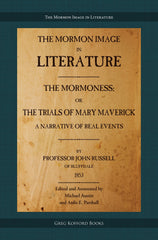 |
The Mormon Image in Literature Series The Mormoness; Or, The Trials Of Mary Maverick: A Narrative Of Real Events Published in 1853, the first American novel about the Mormons is also one of |
 |
The End of the World, Plan B: A Guide for the Future Environmental decline, political gridlock, war and rumors of war, decadence, |
Also forthcoming...
More volumes are in the works for our The Mormon Image in Literature, Contemporary Studies in Scripture, and Perspectives on Mormon Theology series.
Saints, Slaves, and Blacks by Newell G. Bringhurst, revised and updated
Lot Smith: Utah Hero, Arizona Colonizer by Carmen Smith and Talana Hooper
The Trek East: Mormonism Meets Japan, 1901-1968 by Shinji Takagi
Science the Key to Theology by Steven L. Peck
And much, much more...
Thank you for making 2015 exceptional and we are excited about 2016!
20% off all Kofford titles through the month of December! December 01 2015

'Tis the Season!
Greg Kofford Books is pleased to offer 20% off all titles ordered December 1st through December 31st. Simply enter "MERRY" into the discount code box at check-out to get your discounted price.
Orders placed by December 15th will have the highest likelihood of being received before Christmas. Customers living along the Wasatch Front can select the "pick-up" option during check-out to avoid shipping costs and pick up their orders directly from our office in Sandy, UT.
*Don't forget about our Twelve Days of Kofford daily book giveaway contests on Facebook running Dec 1st - 12th. Click here for details!


